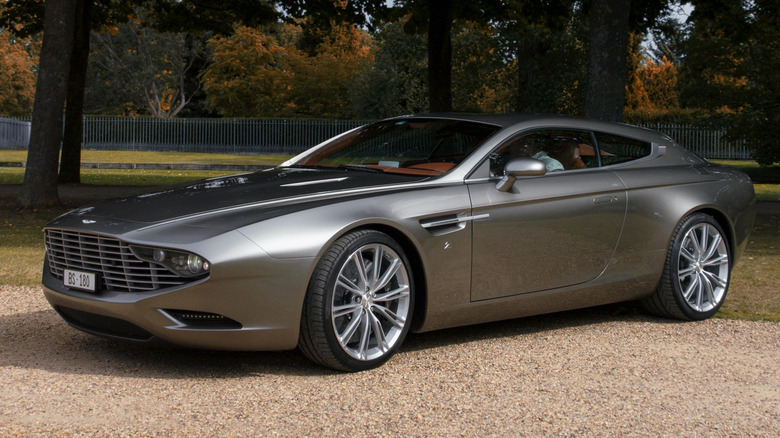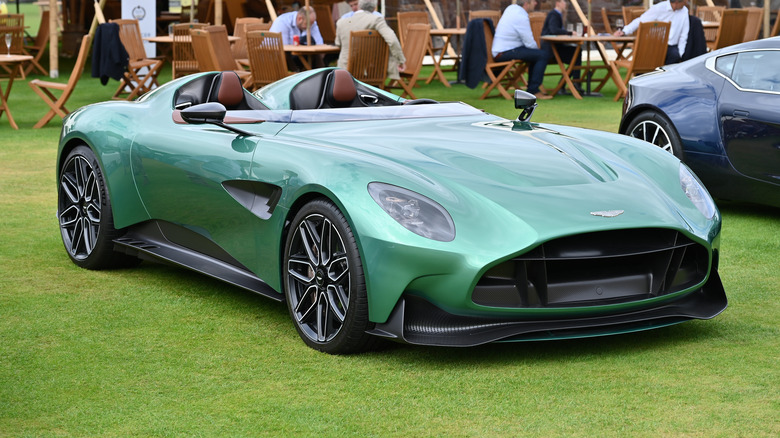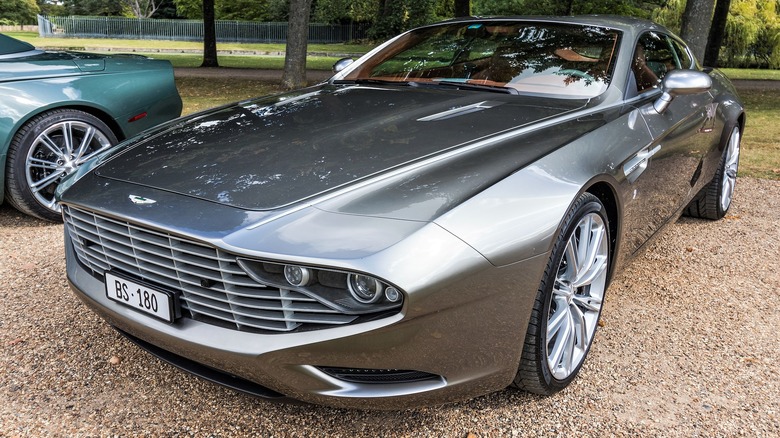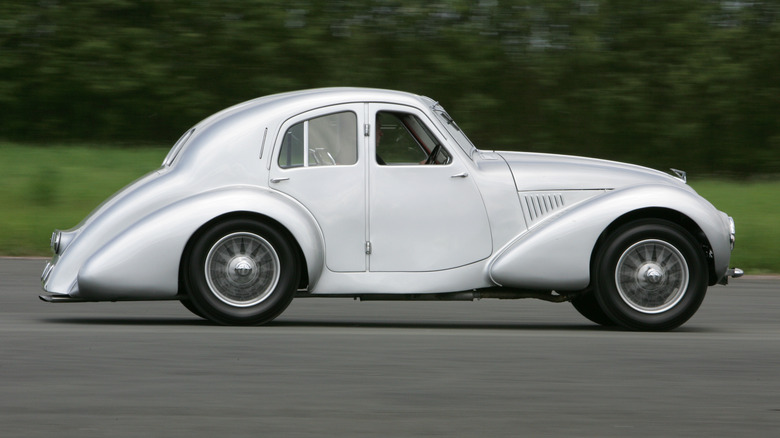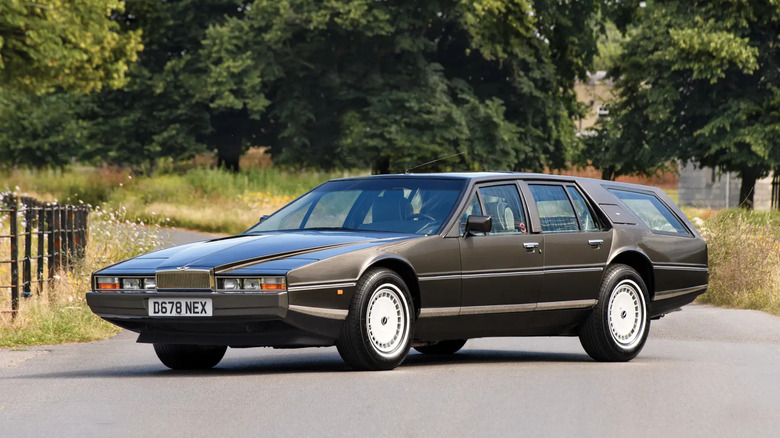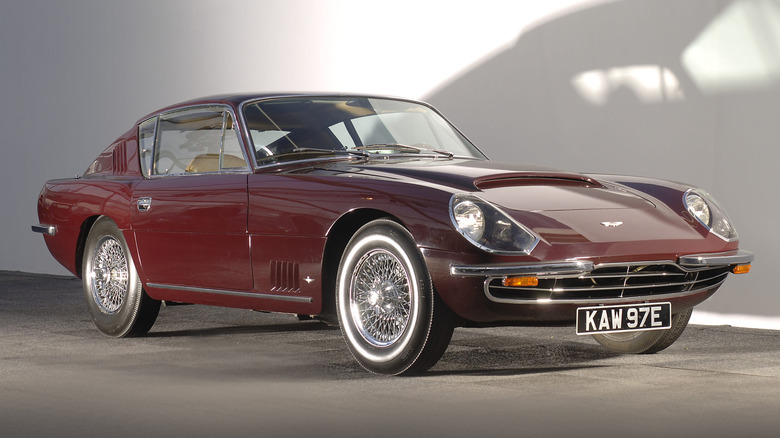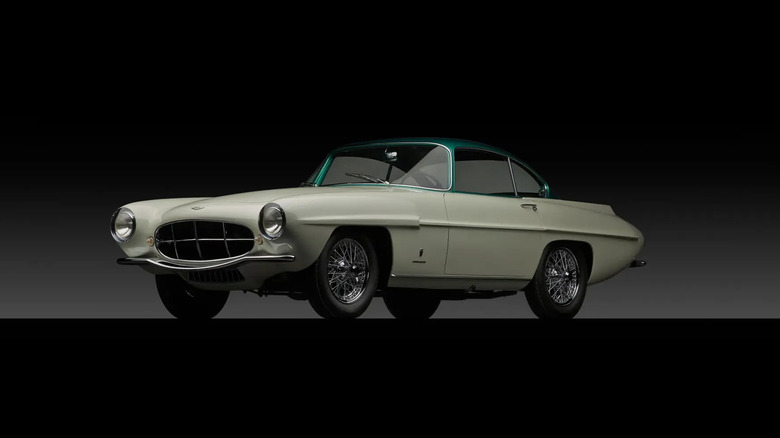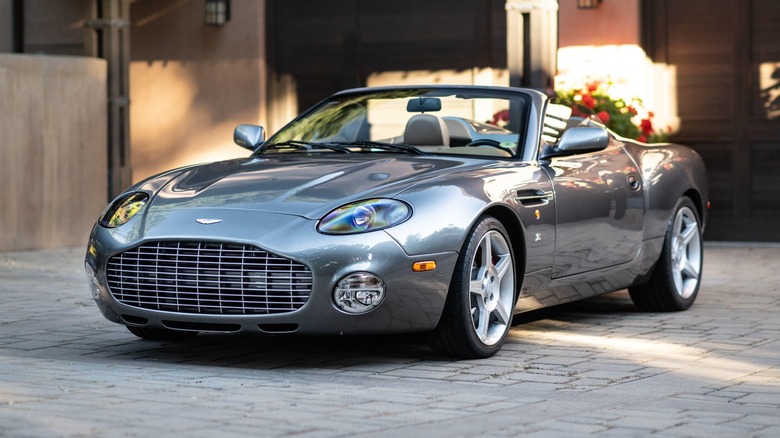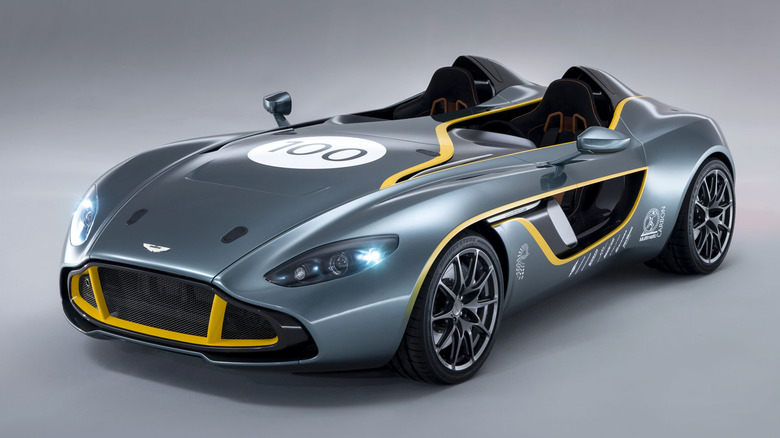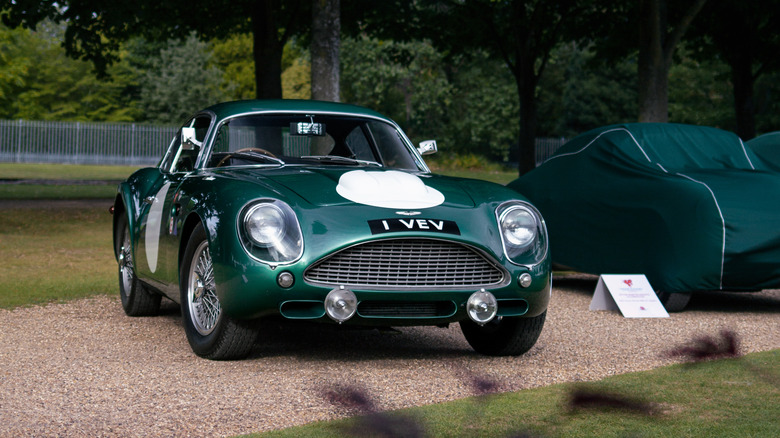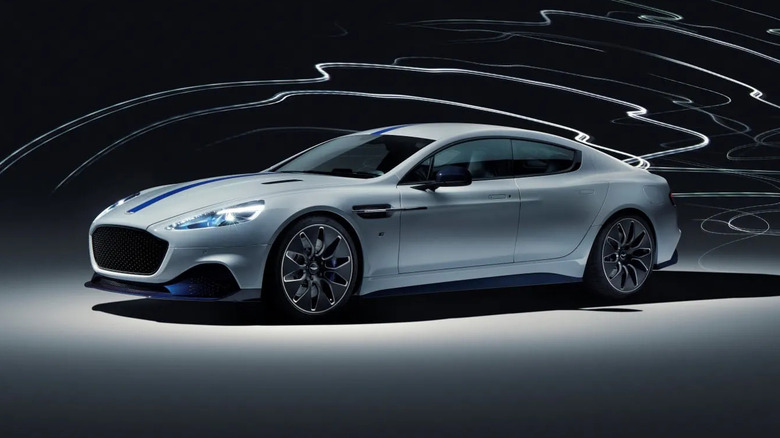10 Aston Martin Models You Didn't Realize Existed
Aston Martin's century-plus of existence hasn't always been an easy ride. The company has faced a litany of financial issues that have pushed it to the brink of closure multiple times, but each time, it has managed to survive, much to the relief of enthusiasts. Arguably the biggest reason it repeatedly managed to find investors to help it fix its cash flow issues is its long and storied heritage, with the brand having produced a long line of iconic cars for both the track and the road.
Classics like the DB5, V8 Vantage, and Virage helped Aston Martin build a worldwide base of enthusiasts, and recent releases like the Valkyrie hypercar and DBX super-SUV helped introduce the brand to a new generation of fans. However, for all of the brand's well known nameplates, there are a few lesser known rarities that inevitably get forgotten about — or never discovered — by those followers of the brand. These cars are among the most obscure, being only occasionally exhibited at exclusive concours events and heritage meets. As a result, many Aston Martin fans might not even know they exist.
Aston Martin DBR22
Aston Martin has released a slew of hypercars, one-offs, and special editions in recent years, and as a result it's easy to miss some of them. One of the more overlooked specials is the DBR22, which was unveiled at Monterey Car Week in 2022. It was the product of the brand's "Q by Aston Martin" division, which creates bespoke cars for the brand's most loyal (and well-heeled) clients. It borrows styling cues from the brand's classic open-seat racers including the DBR1, which became the most expensive British car ever sold at auction in 2017 when it sold for $22.5 million.
Its styling might be classic, but the construction of the DBR22 is very much cutting edge. Its twin-turbo 5.5L V12 engine churns out over 700 horsepower and part of its subframe is made from 3D-printed aluminum components, a first for the brand. As well as helping to optimize weight, 3D printing components also makes it less costly for Aston Martin to produce custom parts for extremely low volume cars. No official production numbers were given by the brand, but a report by Autocar claimed that 10 examples were to be built at a price of £1.5 million (around $1.86 million at the time).
Aston Martin Virage Shooting Brake Zagato
Aston Martin has had a decades-long relationship with Zagato, and the partnership has produced a number of high-profile special editions in recent years. Most enthusiasts will already be aware of the V12 Zagato and Vanquish Zagato, but one collaboration that tends to slip under the radar is the Virage Shooting Brake Zagato. Unlike the former cars, the Virage Shooting Brake Zagato is a one-off special. It was unveiled in 2013 and was designed to commemorate Aston Martin's 100th anniversary.
Despite its concept car looks, it's no mere design study. Rather, it's a fully functional, road legal one-off car that's now under private ownership. Its grille-integrated lights, extended nose, and shark-like lines give it a look that's unlike any series production Aston Martin. The interior is equally unique, with two-tone cream and tan leather upholstery and prominent Zagato "Z" logos in the headrest.
When it comes to one-offs, it's virtually impossible to estimate their value, and in the case of the Virage Shooting Brake Zagato, the amount its owner paid to buy the car from Zagato isn't public knowledge. In any case, it's not like it matters to most enthusiasts, who are unlikely to ever see the car in the metal, never mind be in a position to buy it should it ever appear for sale.
[Featured image by John Tiffin via Wikimedia Commons | Cropped and scaled | CC BY-SA 2.0]
Aston Martin Atom
Despite being overlooked by many Aston Martin enthusiasts, the one-off Atom prototype is arguably one of the most important cars in the brand's history. It was designed and built between 1939 and 1940, as Britain was ramping up its military production in response to the breakout of the Second World War. Most of Aston Martin's production facilities were converted for military use, with the Atom being the company's only automotive development during the period. After its construction, company owner Gordon Sutherland used it as his personal car, racking up around 100,000 miles in it.
In the years after the war, the Atom was used as a further testbed for Aston Martin's cutting edge innovations, with businessman David Brown test driving it and being so impressed that he decided to buy the company. He adopted elements of the Atom's design into the early iterations of the now-iconic DB series. The Atom was eventually sold off to a private owner, who kept it for decades and continued to use it. By the time it appeared for auction in 2014, it sported a remarkable 250,000 miles on the clock. It didn't meet its reserve at auction so remained with its original owner, and has not been offered for auction again since.
Aston Martin Lagonda Shooting Brake
Created as a coachbuilt one-off by a Swedish automotive designer, the Aston Martin Lagonda Shooting Brake took an already unusual looking car and made it even more distinctive. It appeared for auction at RM Sotheby's having only been sold once previously in 2006. Up until that first sale, the car had been a factory-standard example of the Aston Martin Lagonda sedan, which was already a rare car, with 645 examples built. Its second owner decided to convert it into a one-off custom build, with the process documented through a Swedish TV show.
It took several years for the build to be completed, and it's not known how much the final bill came to. The car sold at auction in 2019 for $98,000, which is significantly higher than the average selling price of a standard Lagonda, although still a way off what the most valuable examples of the model have fetched.
Aston Martin DBSC
Although the British manufacturer is most famous for its collaborations with Zagato, Aston Martin has worked with a number of other famous Italian design studios over the decades. It collaborated with Pininfarina and Coggiola to build the Aston Martin AM3 for the Sultan of Brunei, and worked with Touring to create the ill-fated DBSC. First unveiled in 1966, the DBSC was Touring's vision of a successor to the DB6, and was based on the outgoing car's underpinnings.
However, the sleek, flowing design of the DBSC had meant that the engine needed to be repositioned, and as a result, would need a lot of additional work before it could be signed off for production. Aston Martin didn't have the capacity to take on the work by itself and Touring ran into serious financial issues that resulted in its factory being sold off. As a result, just two examples of the prototype DBSC were built before production plans were abandoned.
Aston Martin DB2/4 Mk II 'Supersonic' Ghia
Ghia and Aston Martin would later work together on concepts like the 1993 Lagonda Vignale when both brands were under Ford ownership, but several decades before they became stablemates, the two had already collaborated on a one-off show car. The Aston Martin DB2/4 Mk II 'Supersonic' by Ghia was unveiled in 1956 at the Turin Auto Salon, and was the only Aston Martin to ever feature Ghia's distinctive Supersonic bodywork. Other cars to be given the Supersonic treatment include the Jaguar XK120, Alfa Romeo 1900, and most famously, the Fiat 8V.
The unique Aston Martin was sold to a private client in New York shortly after its unveiling, and passed through several more high profile owners in the city before eventually being sold to an owner in Detroit. It was eventually parked at an abandoned gas station in Detroit and remained there for around three decades, until it was purchased by a new owner and subject to an extensive restoration. It eventually appeared for sale at an RM Sotheby's auction in 2013, where it sold for $2.31 million.
Aston Martin DB AR1
Another lesser-known Aston Martin Zagato special edition, the DB AR1 officially debuted at the 2003 Los Angeles Auto Show. It was built specifically for the American market — the "AR1" in the name stands for "American Roadster 1" — and it was based on the bones of the DB7. It retained the DB7's V12 engine, but boasted a slight power boost over the standard car to 435 horsepower. A new exhaust was also developed to give the DB AR1 a distinctive soundtrack.
Like all Zagato special editions, the car's styling is its biggest draw, with the DB AR1 being given a thorough bodywork overhaul including a unique oversized grille and round taillights. There was no double-bubble roof here, though. In fact, there was no roof at all, as the DB AR1 was strictly an open top car. A total of 99 examples were produced and all were reportedly sold before the car had officially been unveiled. The pictured example appeared at a Bonhams auction in August 2024 with just 1,175 miles on the clock.
Aston Martin CC100
Originally intended to be only a concept car, the CC100 was created by Aston Martin to celebrate 100 years of its existence in 2013. Much like the later DBR22, it took heavy inspiration from the DBR1 that won Le Mans in 1959. The stripped-back design featured nothing that didn't absolutely need to be there, to the degree that there was no windshield, roof, or windows. That made it even more extreme than the DBR1, which at least had a small windshield to protect occupants from hazards.
The CC100 was clearly envisioned by its designers as a unique track day toy, but that didn't stop one wealthy client from commissioning their own example and insisting it be put through the lengthy approval process for road use. By that point, a second client had already stepped in to buy the original track-only concept car, leading Aston Martin to reportedly block any further orders since the company didn't want to launch a production run. It's not known how much the road-legal car cost its buyer, but the concept was reportedly sold for around £500,000 (roughly $780,000 at the time).
Aston Martin DB4 GT Zagato Continuation
First shown to the public in 1960, the original Aston Martin DB4 GT Zagato (pictured above) boasted a new, aerodynamic body courtesy of the Italian design house and an upgraded engine making 314 horsepower. Built as a more exclusive evolution of the DB4, Aston Martin originally intended to build 25 examples of the car. However, the planned production run was never completed, with the final six planned cars never being built.
In 2019, a continuation of the original car was announced by Aston Martin, with each one to be hand-built at the firm's specialist Works division. A run of 19 examples were announced to match the '60s car. Many of the classic coach-building techniques used to build the original cars were carried over to the production of the continuations, although with the addition of what Aston Martin called "sympathetic application of modern engineering advancements." The car was only available to buy as part of the brand's DBZ Centenary Collection, which started at £6 million (around $7.66 million at the time) plus taxes.
Aston Martin Rapide E
As of this writing, Aston Martin has yet to release an all-electric car. However, back in 2019, the brand announced its intention to launch the Rapide E, a limited-run electric version of its four-door Rapide. It was to be limited to 155 units, feature a range of "over" 200 miles, and would be limited to 155 mph. It could reach 60 mph from standstill in under four seconds according to the brand. The car that debuted in 2019 at the Shanghai Motor Show was billed as production ready, and the brand claimed it would be built at a new dedicated EV production facility.
This, of course, didn't happen. Aston Martin reversed course in 2020 with Autocar claiming the car was demoted to being "a research project." This was likely down to a combination of factors. It's possible that the car didn't generate enough interest among clients — a scenario that seems all the more likely given how many enthusiasts have already forgotten about the Rapide E, if they were aware of its existence in the first place.
The second is that Aston Martin's finances were simply too shaky to justify the launch of such an ambitious project, with the company forced to issue profit warnings to investors that year in the wake of disappointing sales. The Autocar report claims that the decision was made to instead focus development funds on the DBX, which given the SUV's sales success, seems to have been the right move.
